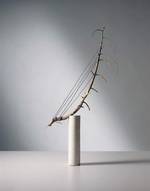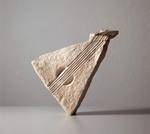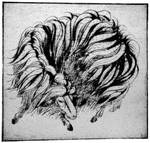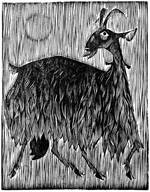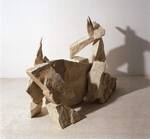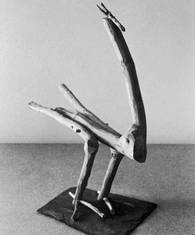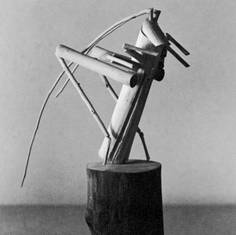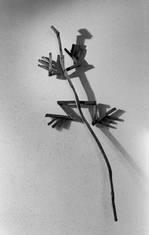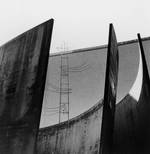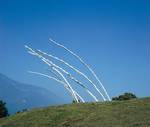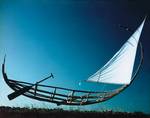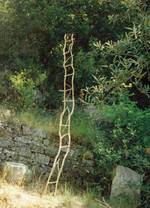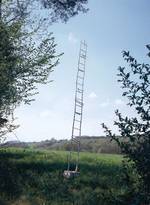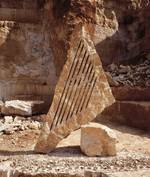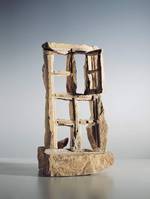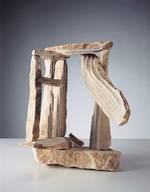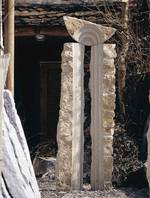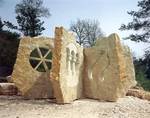The Strings of Nature’s Body – On the Works of René Küng
Nicolaj van der Meulen
A Mouth for Nature
The smooth song of Orpheus would tame even the wildest creature. A deer approaches the son of a muse, but in the hands of the singer, the animal’s antlers are transformed into the body of a lyre. René Küng has reinvented the myth of Orpheus with this unusual image. His early miniature sculpture (1958) is about the joyful moment when nature turns into an instrument that resonates in the hands of the artist.
Music in its different forms is a recurrent element in the works of the sculptor. He himself is possessed by music: “Strings run through my body. Not down its length, but diagonally”. The metaphor of the artist as an instrument illustrates the many transitions occurring when experiences made in nature or in everyday life find their way into a sculpture. In the eighties and nineties appeared the Cantos made of painted or raw wood, followed by the Harfen (harps) und Lauten (lutes) in limestone and granite. These works, although they do not focus on the human aspect, are clearly made for humans. As much as they want to be seen, they want to be heard.
In spite of differences concerning the technical treatment of material, Küng’s “musical sculptures” have a lot in common with similar works such as Cy Twombly’s Orpheus (thou unending trace) (1979). Nevertheless, a comparison also quickly reveals the differences. Küng’s “instruments” are not only based on different materials, they also interact with the surrounding landscape. This is why the Steinharfen (Stone Harps) and Cantos, exposed to the wind, could be called “visual music”. The rhythmical layers and undulations of the Cantos reflect the rhythm of nature. Between the stone strings of the Harfen, the elements play their song. Whoever walks around the sculptures and looks at them attentively will also be able to hear nature: Küng’s musical works teach us to listen to nature. The blood of the dying Orpheus seeping into the earth made nature resound and it, too, brought man song and the musical ear. Rilke’s Sonnets to Orpheus end with the thought: “Only since blind hatred strewed you about are we now hearers and a mouth for nature” (translation by Howard A. Landman).
Beginnings with a Goat
René Küng was born in Allschwil in 1934. After being apprenticed as a stonemason in Basel, he leaves Switzerland for extensive journeys through France and Spain. In 1957, he rents an old farmhouse in Ibiza for six months. However, this has little to do with the escapism of a hermit. It is an experience of unity between man and nature, leading to a special form of artistic creation: the artist enters into his dialogue with nature.
Here, on Mediterranean soil, he takes first artistic steps. Along with sketches and watercolour paintings, Küng starts experimenting with wood, stone and clay. The initial subjects are found in the observation of everyday situations, while watching craftsmen and shipbuilders do their daily work. Each day, a woman working on a neighbouring farm passes the artist’s house with her goat. The clay model of this goat, created at that time, has not been preserved. Since the beginnings of a development often remain obscure, this lost goat can be described as the starting point of René Küng’s activity as a sculptor. Later, the mature artist will repeatedly come back to the subject of the goat with its head tilted backwards and to the side.
Biographical information shows that his decision to become an artist and his choice of a rural lifestyle are inseparable from the subjects of his sculptural works. The observation of animals is now a primary source of inspiration. Later, in the eighties, Küng creates heads, parts of the body and torsos of animals made in acacia wood, firtree wood and limestone. Besides rams and goats, it is the smaller animals that concern the sculptor. In 1982, the Heupferd (Grasshopper Horse) and the Waldvogel (Forest Bird) are created, followed by the Mauereidechse (Wall Lizard) one year later, and by the Heuschrecke (Grasshopper) in limestone in 1985. These works are just a few examples of the output of that period. What connects these with other works is the choice of material, always responding to the anatomy of the animal: pieces of wood and branches carefully selected for shape are transformed into the swollen chest of a bird, the trembling antennae of a grasshopper or the tense spinal column of the wall lizard. The choice of a natural material unites these animals with their environment. These animals seem to breathe the free space around them, without reflecting their past or future. The character of their movements and postures are selfevident, emanate from their lifeform. Hence, Küng’s animals demonstrate unity with nature, a unity that humans lose when they are born.
All this is shown without sentimentality. Unlike Franz Marc’s Tierschicksale (Animal Destinies) (1913) or Arnold Böcklin’s Kentaurenkampf (Centaur Fight) (1872), Küng’s animals are not parables for the failures of humankind, nor are they exemplary descriptions of natural historic processes – they simply represent animals in their uncomplicated directness. Küng’s animals act on what the instant prompts them to do. They do not pause to consider, which explains their unity with nature.
Maybe ...
René Küng is not an artist trying to separate a finished work from the conditions of its making. People in front of the Basel Theatre looking at the Mondleiter (Moon Ladder) (1980) will not only follow the upward direction that the ladder is taking, they will also see where it comes from. The Mondleiter shows its origins. However, this does not mean that Küng’s works, once completed, have no life of their own. On the contrary: the towering, slender branches are not at all affected by the presence of Richard Serra’s massive, curved steel plates, which were put next to them twelve years later. One reason for this may be that the Mondleiter clearly shows how it was made and what it is made of. While Serra’s Intersection has placed thick plates between space and the beholder, people can see through Küng’s Mondleiter. This accounts not only for infinite space, which remains visible between the sweeping rungs, but also for the origin and the use of material. Therefore, it is interesting to ask how Küng’s works come into being.
One can hardly expect a simple answer from the artist himself. In conversation, you may get a paraphrasing “maybe” – “maybe it had to do with ..., but I don’t remember exactly.” This has nothing to do with artistic indecision; it simply means that the numerous aspects influencing the work cannot be reduced to a formula. Dreamed figures, seen landscapes and observed events cautiously take initial shapes in the head or as miniature models before they flow together and make a whole. There is no need to find out which drop came from which tributary once it has joined the stream. Observed events are combined with imagined shapes, and personal experiences are mixed with what one could call the memory of culture. Stepping through time, Küng’s works establish links between the present moment and previous stations in cultural history, as well as to the beginnings of civilisation.
One of the cultivated artistic manners of René Küng’s proceeding is that a sculpture can be conceived gradually, over several inner working steps. The sketching is done on an imaginary monitor, into the blue sky or onto an empty white wall. Whatever appears at this stage can be erased at any time. This working method is remarkable in that the focus is already on space as the place for the eventual sculptures, without any detour on paper. Changes are made by an inner corrective, which is always subject to doubt. This doubt is essential for an effective sculpture, as it prevents the work from being created according to a rigid formula. It is determined without being oriented towards a visible direction at this point. Finally, the imagination produces three-dimensional structures, combining sculptural forms with aspects of the drawing. For this reason, the branch, one of the basic sculptural forms in René Küng’s work, could be described as physical line. As in Canto a più voci (1990) – chosen from the the Raumund Himmelstreppen (Spatial and Celestial Stairs), the Leitern and the Cantos made in the eighties and nineties – such physical lines measure the open space, adopting the shapes of the surrounding topology.
However, this invisible designing procedure is only a part of the whole creative process. Wood, stone and bronze are more to René Küng than anonymous prefabricated materials ready to fit into a preconceived design. This can be seen in Unentschlossene Leiter (Irresolute Ladder) (1990), where the concept adapts itself to the natural shapes of stones and branches as found. One could say that Küng takes up the organic history of the material, transforming or extending it. For this reason, Küng’s work goes hand in hand with the material as nature provides it. In other cases, stones and branches may also be used in accordance with their static potential. The thinnest wooden frames achieve a maximum of height, and massive granite is turned into slender, seemingly weightless constructions. If one casts an eye on how the wooden Bateau jurassien (Jurassic Boat) (1978) or the Steinharfe (Stone Harp) (1992) are “made”, one will quickly see that artistic technique is more to Küng than just a means to an end. The way the branches are joined by bending or mortising the material, and delicate cuts are made into stone, are close to archaic techniques of production. For René Küng, each work is also the resolution of a technical experiment, a possible answer to an open question.
Seeing Through
The group of works that are perhaps Küng’s most remarkable and comprehensive are the windows and gateways. These are insofar remarkable in that although they combine the directly visual with sculptures and architectural elements of the past, their true significance lies beyond the whole of these startingpoints. In the eighties, a series of windows made of wood, limestone and granite was created, followed by the Steintore (Stone Gates) in the years 1985/1986. The development culminated in works like the tripartite Steintor for the Bethesda Hospital Basel (1989), the Torstein (Gate Stone) (1990), the Windfenster (Gusty Windows) (1997/98), and the Spatz am Fenster
(Sparrow at the Window) (1999).
Windows and gates create separations and connections between the inside and the outside world. In terms of cultural history, the artistic creation of a gate is linked to the idea that a gate should prepare visitors for a special, sometimes sacred place. Küng’s Torstein and Steintor stand in the tradition of romanesque and gothic church gates such as Saint-Sernim (Toulouse), Saint-Lazare (Autun), and Saint-Pierre (Moissac) or even funeral temples such as Khazne el-Fara in Petra, dating from the first century BC. As they are situated in open space, Torstein and Steintor are also reminiscent of the triumphal arches of the Roman Empire. However, Küng’s spatial openings differ from their precursors in that they are not framed by walls and cannot be entered or passed through. The connection between “here” and “there” is primarily of a visual nature.
Accordingly, the Steintor in the park of the Bethesda Hospital is not necessarily an invitation to pass through to the other side by stepping around it. The eye is led aloft along the gate’s upwards opening gesture. The Steintor associates the beginnings of culture with a vertical movement, reflecting the upward evolution of humankind. The eyes can do what a fully-grown body cannot: they can wander through the stone. The essential thing does not happen beyond, but within the gateway itself. This is why the term “transparent openings” seems to me a better characterization of Küng’s gateways than the notion of thresholds that one could cross. The gaze through massive stone allows us to experience what our eyes are capable of: transcending the limits of the body.
This aspect partly releases his “transparent” gateways from their traditional function as portals or doorways. They open up new areas of meaning: the shrine of the world beyond is no longer a confined space, but the open countryside, freely lying here as much as there. Moreover, the sculpture itself shows a deep communion with nature. The rock, shaped in some places and left untouched in others, shows the capability of humans (and artists in particular) to transform nature. In the Mondtor (Moon Gate) (1987) for example, the end of the arch and the moon, artistic creation and universe, are one.
The view of nature through Küng’s wood and stone windows may at first remind one of the romantic window theme as cultivated by Caspar David Friedrich and Philipp Otto Runge at the beginning of the nineteenth century. Küng connects this traditional painting subject with aspects of architecture. At the same time, the window is liberated from its architectonic restrictions. Rather than put a painted figure in front of a window Küng places the viewer himself there, of course without the possibility of passing through it. The romantic notion of yearning to leave a dark room and step out into the bright countryside is only a secondary theme. The Windfester in particular appear to be metaphors for places where human and natural forces, “the I and the world”, meet.
With remarkable sensitivity for the hidden potential of stone, Küng plays with the connections between matter and object. In both Windfenster you will find blowing curtains of stone. In a certain sense, you might say that the sculptor works against the qualities of the material. Gilles Deleuze once wrote: “At a certain speed of the ship, the wave becomes as hard as a marble wall”. In an inverted sense, this reasoning can be applied to the artistic idea behind the stone curtains: here, the stone has an enormous potential for transformation in form and weight. The material is ambiguous. René Küng makes the hidden powers of the wind visible, while the massive material is given the lightness of a transparent curtain.
Books of Nature
Since the mideighties, the artist has also been producing books in limestone, spiralbound and generally not containing more than three or four leaves. The largest of these books is the Steinbuch (Book of Stone) (270 x 340 x 450 cm), created in 1992 and resembling a row of windows lined up one behind the other. But especially the smaller books – such as the Blattskizzenbuch (Sketchbook of leaves) (1985), no larger than 8 centimetres in size – show that with Küng monumental works and miniatures come sidebyside. They capture in a nutshell the artist’s basic ideas.
Just as the Windfenster combine illustrative qualities with sculptural forms, the “books” contain “sketched sculptures”. Generally speaking, stone as an artistic material is associated with firmness, validity and durability, whereas the sketch suggests something provisional and ephemeral. Küng’s stone sketchbooks are by reason of their nature exactly between these two polarities. They combine durability with the ephemeral and bridge a gap between different art forms, which shows how suited they are to capturing in stone qualities of the living and the organic. The shapes of stars, leaves, archways and landscapes emerge from the areas where the stone is pierced, the resulting open space serving as a background.
When, in the fourteenth century, the German clergyman Konrad of Megenburg translated into German the Liber de natura rerum, written a hundred years earlier by the Flemish Dominican friar Thomas of Cantimpré, people may have stood equally amazed in front of this Book of Nature as we now stand before René Küng’s sketchbooks, some 450 years later. They demonstrate the limits of the world as well as the works of nature and men. Creative phantasy finds its way into the sculptures and shows what stone is capable of in the hands of an artist: to render visible man as a part of versatile nature. Hans Christian Andersen once said: “Folios turn yellow, the erudite radiance of cities turns pale, but the book of nature is newly edited each year”.
English translation
Georges Wyrsch and Alec Tempelton

